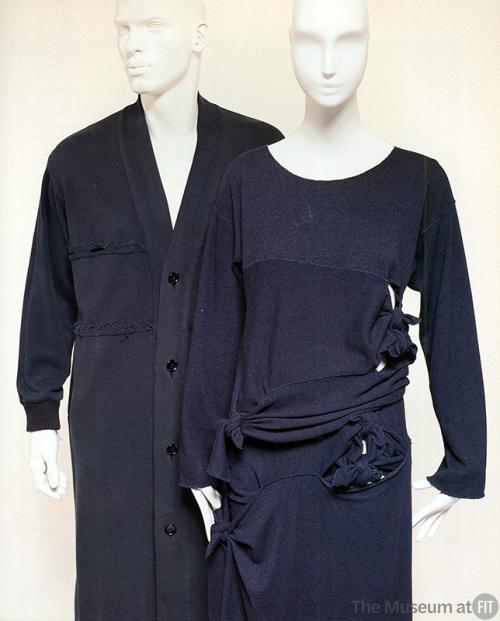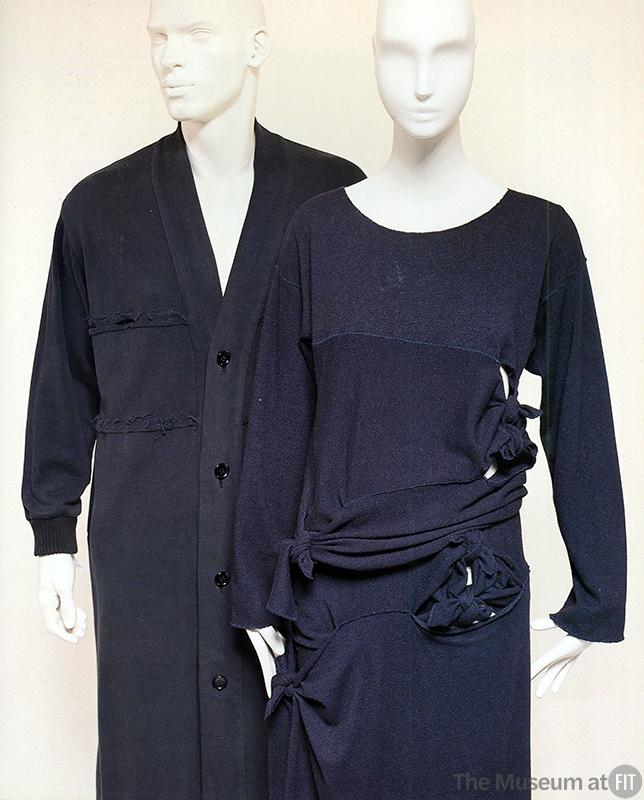
Comme des Garçons
Japanese, founded 1969
Contemporary high fashion as exemplified by Rei Kawakubo had a seismic, course-altering impact on women’s clothing in the late twentieth century. Her work proved revolutionary soon after its international debut in the early 1980s. She is, along with Yohji Yamamoto, rightfully credited with instigating the profound aesthetic changes that have since permeated all levels of fashion—such as deconstruction, obfuscation of the body, and a predilection for the color black.
Born in 1942, Rei Kawakubo, studied literature and philosophy at Keio University before becoming a fashion stylist in 1967. Two years later, dissatisfied with the kinds of clothing available, she began designing her own. She formed her limited company in 1973, calling it “Comme des Garcons,” French for “like the boys.” In the 1980s, Kawakubo expanded her Comme des Garçons empire to include: free-standing boutiques; diffusion lines; and collaborative agreements with companies ranging from ballet shoemaker, Repetto, to swimwear giant, Speedo. Most importantly, she hired a “universe” of young designers, “one superstar at a time.” This universe included young talents like Junya Watanabe, Jun Takahashi (whose label is “Undercover”), and Tao Kurihara.
From the beginning, “intellectualism” has been the defining element of Kawakubo’s work. In her overriding desire to create fashions that defy conventional beauty—while simultaneously redefining what we see as fashionable—Kawakubo has become the quintessential postmodern designer. Often, her sometimes “indefinable” clothing is visually puzzling. As fashion journalist Bernadine Morris noted: “Rei Kawakubo of Comme des Garçons is widely recognized as having the purest vision and the most powerful approach to fashion . . . There is hardly a glimpse of the body as arms were thrust through openings in cape-like tops, and clothes were layered in the prevailing Japanese manner.”
It should be noted that Kawakubo is a designer who had no formal fashion training. This fact is important because, like another great female couturier, Elsa Schiaparelli, her skills reside not in her fingertips but in her ability to engage in theoretical discourse. Despite her lack of technical training, Kawakubo is among the most respected fashion creators in the world. Her fellow designers, as well as curators, journalists, and consumers, view her as the most compelling and innovative fashion designer of the past thirty years.
Born in 1942, Rei Kawakubo, studied literature and philosophy at Keio University before becoming a fashion stylist in 1967. Two years later, dissatisfied with the kinds of clothing available, she began designing her own. She formed her limited company in 1973, calling it “Comme des Garcons,” French for “like the boys.” In the 1980s, Kawakubo expanded her Comme des Garçons empire to include: free-standing boutiques; diffusion lines; and collaborative agreements with companies ranging from ballet shoemaker, Repetto, to swimwear giant, Speedo. Most importantly, she hired a “universe” of young designers, “one superstar at a time.” This universe included young talents like Junya Watanabe, Jun Takahashi (whose label is “Undercover”), and Tao Kurihara.
From the beginning, “intellectualism” has been the defining element of Kawakubo’s work. In her overriding desire to create fashions that defy conventional beauty—while simultaneously redefining what we see as fashionable—Kawakubo has become the quintessential postmodern designer. Often, her sometimes “indefinable” clothing is visually puzzling. As fashion journalist Bernadine Morris noted: “Rei Kawakubo of Comme des Garçons is widely recognized as having the purest vision and the most powerful approach to fashion . . . There is hardly a glimpse of the body as arms were thrust through openings in cape-like tops, and clothes were layered in the prevailing Japanese manner.”
It should be noted that Kawakubo is a designer who had no formal fashion training. This fact is important because, like another great female couturier, Elsa Schiaparelli, her skills reside not in her fingertips but in her ability to engage in theoretical discourse. Despite her lack of technical training, Kawakubo is among the most respected fashion creators in the world. Her fellow designers, as well as curators, journalists, and consumers, view her as the most compelling and innovative fashion designer of the past thirty years.

